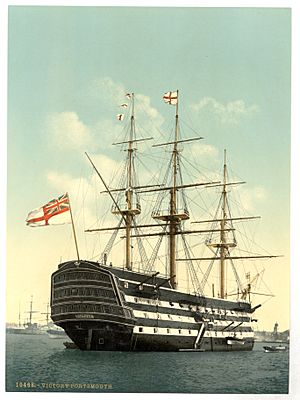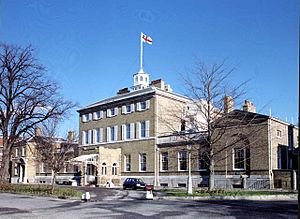Commander-in-Chief, Portsmouth facts for kids
Quick facts for kids Commander-in-Chief, Portsmouth |
|
|---|---|

HMS Victory, flagship of the Commander-in-Chief, Portsmouth
|
|
| Active | 1667–1969 |
| Country | |
| Branch | |
| Type | Area command |
| Part of | Admiralty |
| Garrison/HQ | Dockyard Commissioner's house, Portsmouth |
The Commander-in-Chief, Portsmouth was a very important leader in the Royal Navy for many, many years. This role existed from 1667 until 1969. These commanders were first based in a house on High Street in Portsmouth starting in the 1790s. Later, they moved to Admiralty House inside the Royal Navy Dockyard, where they stayed until the role ended. Before World War I, this leader was sometimes called the Commander-in-Chief, Spithead.
The area this commander was in charge of stretched along the south coast of England. It went from Newhaven in East Sussex all the way to Portland in Dorset. From 1889, the famous ship HMS Victory became the official ship for the Commander-in-Chief.
Contents
A Look Back: The History of the Command
In the late 1700s, important naval leaders called port admirals started living on land instead of on their ships. The Commander-in-Chief, Portsmouth, was given a large house at 111 High Street. This house was renamed Admiralty House.
Later, around the 1830s, Admiralty House was sold. The Commander-in-Chief then moved into another building. This was the old house of the Dockyard Commissioner, which you can still see today inside HMNB Portsmouth.
The Command During World War II
During the Second World War, the main headquarters for this command was at Fort Southwick. This was a very busy time for the Royal Navy.
One important event was Operation Aerial in 1940. This was a huge effort to evacuate soldiers and supplies from French ports in western France. Admiral William Milbourne James, who was the Commander-in-Chief at the time, led this operation. He worked hard to gather all sorts of ships, from large troopships to small coastal boats, to rescue people and equipment.
During the war, several other naval officers were appointed to help manage different parts of the coast. For example, there were officers in charge at places like Southampton, Weymouth, Newhaven, and Poole. This helped to keep the coastline safe and organized during the conflict.
Joining Forces with NATO
In 1952, the Commander-in-Chief, Portsmouth, also took on a new international role. They became the Commander-in-Chief, Channel (CINCHAN) for NATO. NATO is a military alliance between many countries. This meant the admiral at Portsmouth was also in charge of naval operations in the Channel area for NATO.
The End of an Era
In 1969, the role of Commander-in-Chief, Portsmouth, was combined with another important naval role, the Commander-in-Chief, Plymouth. Together, they formed a new position called the Commander-in-Chief, Naval Home Command. This change happened as the British Armed Forces were reorganized after the Cold War.
The Commander-in-Chief, Portsmouth, was in charge of the central part of the English Channel. This area was between Newhaven and the Isle of Portland. Many different naval units and leaders worked under this command.
From 1832 to 1969, the Commander-in-Chief had a Chief of Staff to help them.
Key Senior Officers
Here are some of the important senior officers who served under the Commander-in-Chief, Portsmouth:
| Admiral Commanding | Dates | What they did |
|---|---|---|
| Admiral-superintendent, Portsmouth | 1832–1969 | Managed the Portsmouth Dockyard. This role was later renamed Flag Officer, Portsmouth and Admiral Superintendent. |
| Senior Naval Officer, Portland | 1908–1914 | A Captain or Rear Admiral held this role. |
| Flag Officer-in-Charge Portland | 1914–1958 | This officer was in charge of naval operations at Portland. |
| Commodore RN Barracks, Portsmouth | 1898–1969 | This person was in charge of the naval barracks in Portsmouth. |
Commanders-in-Chief Over the Years
Many important naval leaders held the position of Commander-in-Chief, Portsmouth, over the centuries. These admirals played a key role in protecting Britain's coasts and leading naval operations. The role was held by a long line of distinguished officers from 1667 until it was merged with another command in 1969.


